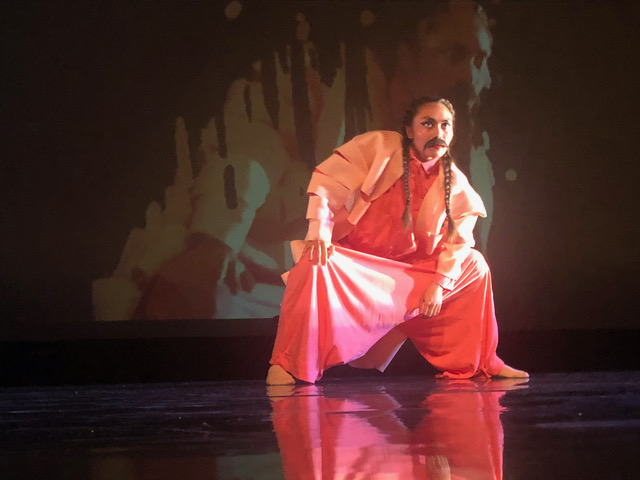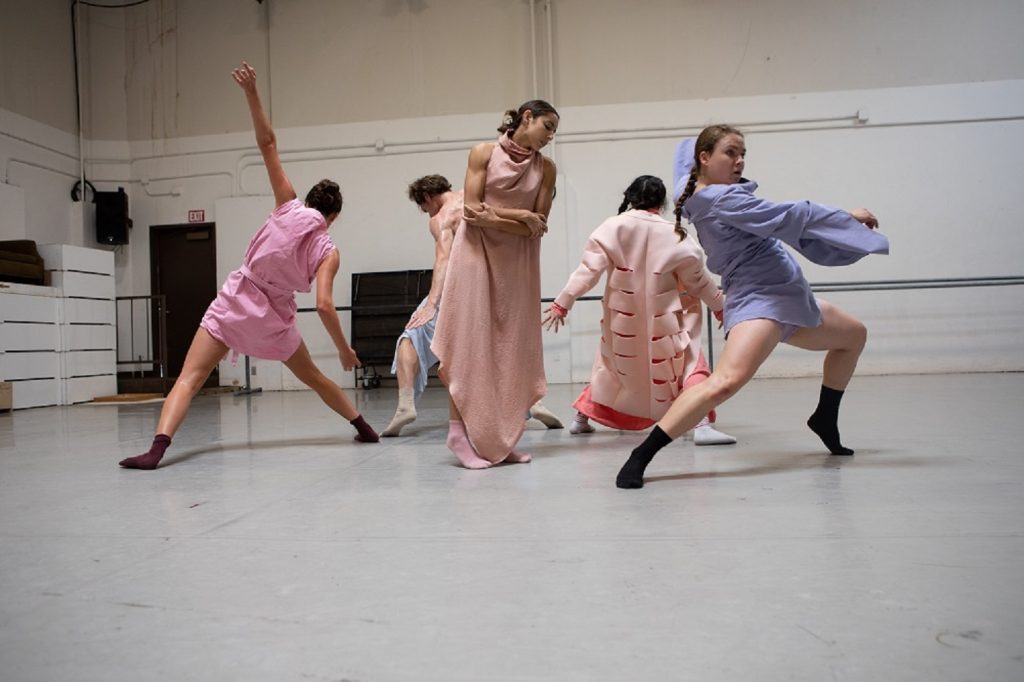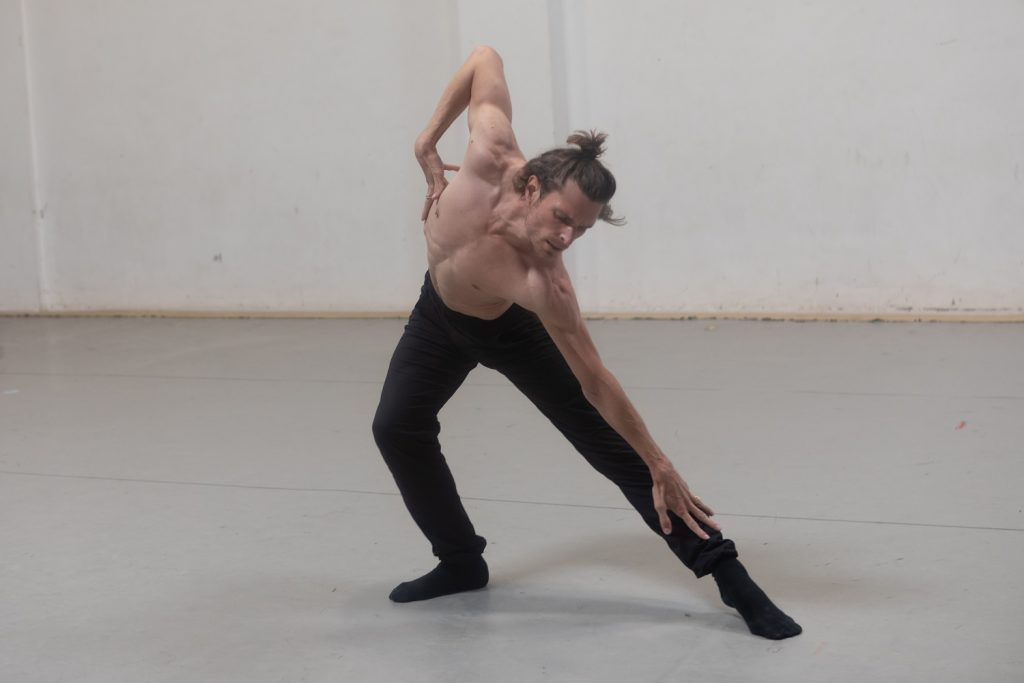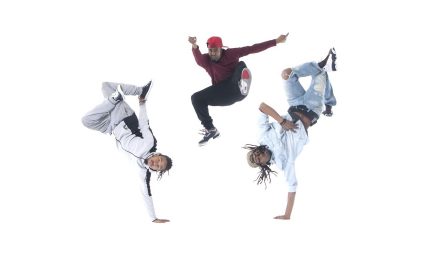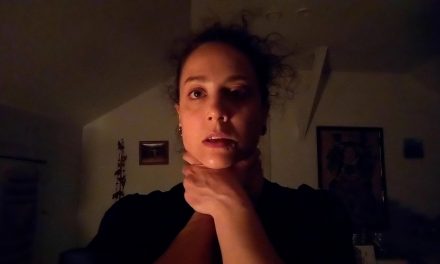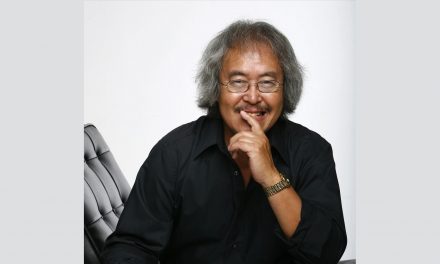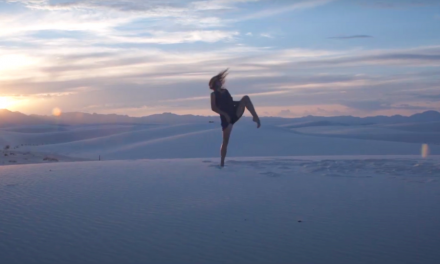The cartoonish gestures of a certain former president, bullying’s effect on the victim and the perpetrator, the seep of dementia, the police suffocation of George Floyd, climate change—all have been grist for the creative juices of choreographer Laurie Sefton. For Sefton, headlines and social media buzz are not for literal reenactment but a starting point for larger considerations of ripple effects and underlying layers of causation. At a recent rehearsal for her upcoming performances at Stomping Ground, Sefton talked about how she hopes the two pieces being performed speak more deeply than headlines or echo chambers.
“I feel like I have to do something relevant to what is happening in the world,” Sefton states with a tone somewhere between confession and point of pride as she described how she seeks to peel away layers to go deeper. Her newest work, The Mythology of Self, evolved from observations on social media during two years of pandemic quarantine. The second work premiered last year, but when its themes were given new urgency in the wake of the Supreme Court majority denial that any federal right to abortion existed, Sefton felt compelled to revisit the larger issues raised in Women, Fire, and Dangerous Things.
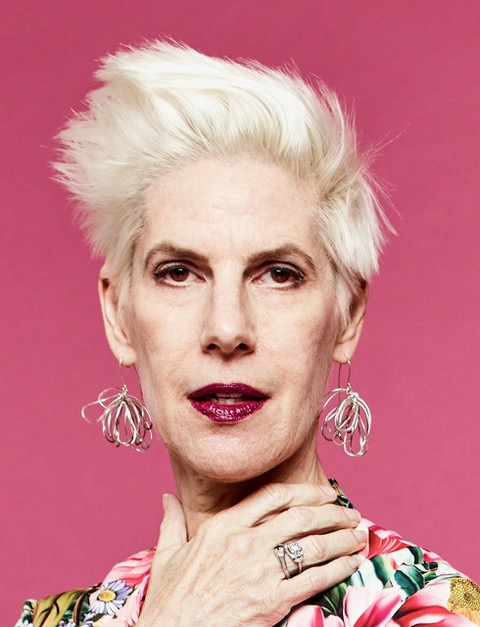
Laurie Sefton. Photo by Tatiana Wells
Before the afternoon run-through, Sefton introduces those present. The six dancers are Alisa Carreras, Emily Krenik, Madeline Lacambra, Mizuki Sako, Sidney Scully, and Nicolas Sipes, most of whom are working with the choreographer for the first time. Also in the room are mezzo soprano Carmen Voskuhl and Denise Leitner, one of the photographers actively part of the action.
The new work, The Mythology of Self, was developed on students at a Loyola Marymount University. That LMU workshop allowed development of costumes and music as well as choreography which Sefton later expanded as she worked with the professional dancers for this premiere.
As five dancers finish warming up in different corners of the large studio, Sefton describes the spark for The Mythology of Self came during the pandemic when social media became a major way of connecting during the extended quarantine.
“Those months of quarantine were a time of great personal reckoning. I saw people coming out over their social media, changing the way they looked, showing other sides of their personality that I did not know. People were opening up, rebranding, refiguring who they were as individuals, and using social media to change who they were” Sefton explains.
She also saw on social media how some people were mentally not ok.
“Social media brought out things they had not grappled with. I know people who were not ok during the pandemic, are not ok coming out of the pandemic, and are not going to be ok for a long time. I try to address that too in the work.”
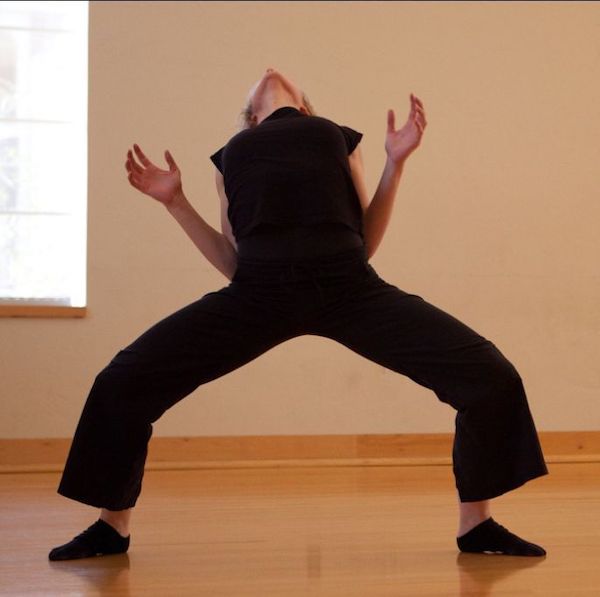
Laurie Sefton Creates. Photo courtesy of the artists
Most of the five dancers present an amalgam of Sefton’s observations over her time on social media, but one dancer portrays a specific personality, a Sefton acquaintance who, on social media, represented herself with a mustache.
“That made me think, men get to representative themselves in drag, and setting aside that women wear suits, I wondered why don’t women get to represent their more masculine side such as wearing a mustache,” she muses.
Sefton describes the flamboyant costumes designed for the workshop that have been donated by LMU. At the time of the rehearsal, three costumes are still undergoing final alterations for the current cast. Two costumes are at the rehearsal, including a multi-layered pink and peach ensemble with oversized pants and an equally oversized, horizontally slashed jacket, and that mustache which is assigned to Mizuki Sako. The quintet of dancers take their places in far-flung areas of the stage and settle into their assigned social media persona as mezzo soprano Carmen Voskuhl begins singing a cappella. The music, some of which will be performed live, is composed either for the work or by composers Sefton has worked with in the past.
A Sefton work forces an audience to choose where to look. A dancer’s solo center stage draws focus, making it a challenge to catch the subtle movements of another dancer far across the stage slowly bringing energy to a character who soon will become prominent.
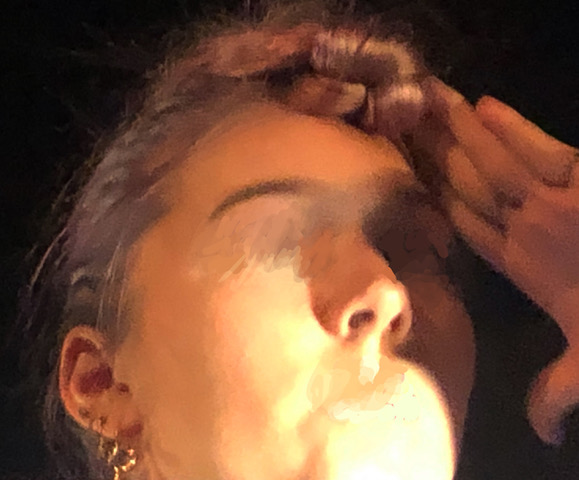
Laurie Sefton Creates “The Mythology of Self.” Photo courtesy of the artists
Inserting elements of social media, Sefton has two photographers Denise Leitner and Skye Schmidt (both with dance backgrounds) moving amid the dancers with their photos projected, in effect “posted,” and then subject to manipulation by visual artists who are also onstage.
The photographers’ movement among the dancers and choice of photographs is entirely situational.
“I did not give the photographers any instruction or choreography,” Sefton explains, “Except where dancers need to be and the photographers need to yield the right of way,” she adds with a smile.
For the rehearsal, only photographer, Leitner, is present to weave among the dancers and shows her own dance background as she shifts from taking a photo with small side step that clears a lane for an oncoming dancer.
After a short water break, dancers Scully and Sako are joined by Maddie Lacambra for the second work Women, Fire, and Dangerous Things.
Originally commissioned last year for an event honoring Marie Curie, in Women, Fire, and Dangerous Things, Sefton initially drew on Curie’s biography, but did not stop there. Set on three dancers, the work abstracts elements of Curie’s work with her husband Pierre Curie on radium that brought her two noble prizes and ultimately killed her with radiation poisoning. The work also references Curie the woman who had a series of lovers while she remained married and working with her husband, as well as a lesser known series of events involving American women when Curie was in need of funding to purchase more radium for her research. A woman in the U.S. led a campaign, largely funded by women that succeeded in raising the needed money for the radium purchase.
“I had to return to this work after the Supreme Court majority struck down the right to abortion because it added issues to the original ones I tackled in Women, Fire, and Dancers Things, particularly the power of the effort entirely led by U.S. women to fundraise the radium purchase for Marie Curie’s research,” Sefton says.
With the Supreme Court majority sanctioning state governments’ unrestricted bans on abortion, Sefton wanted to expand her earlier work to capture the power of current protests and voter activation largely led by women against states enacting criminalized prohibitions that preempt health decisions by a woman and her doctor.
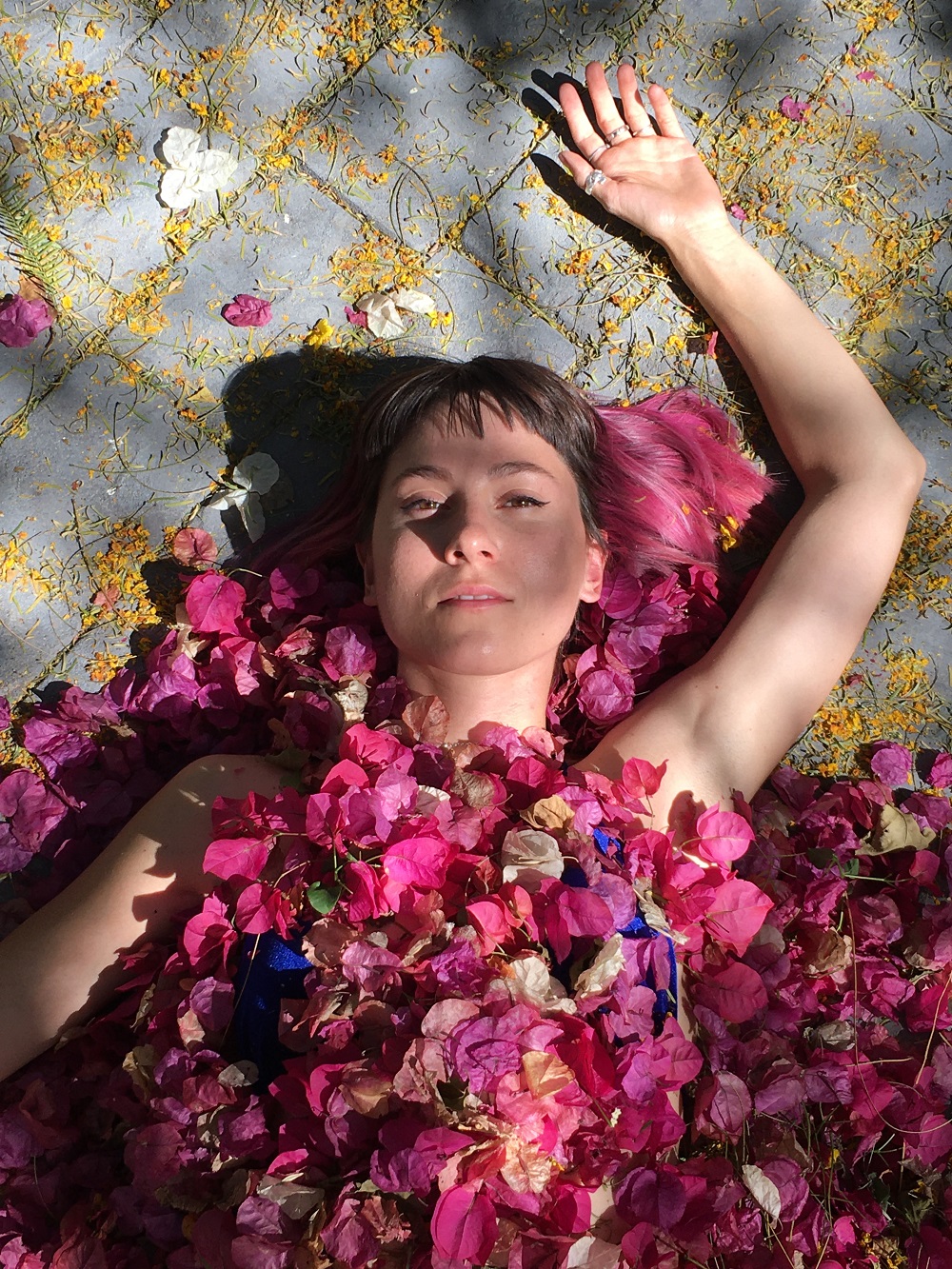
“Women, Fire, and Dangerous Things” choreography by Laurie Sefton – Dancer: Leah Hamel – Photo by Laurie Sefton
Sefton elaborates, “The trio of dancers, collectively and in their solos, still evoke aspects of Marie Curie’s life, but also how Curie’s history of struggle, set back, and perseverance was not, and is not, unique to that one woman scientist. It also characterized the women who organized to fundraise to buy radium, and women who have organized ever since and continue to flex their often unappreciated collective muscle in the face of ongoing setbacks.”
Those who have followed Sefton’s work under the banner Clairobscur Dance may notice her work is now presented as Laurie Sefton Creates. As the rehearsal ends, Sefton responds to a question about the rebranding.
“When I started, my name as a choreographer was less recognized. The name change reflects how the company has evolved and how the work is associated with me,” Sefton explains after the rehearsal. She hastens to add that the original concept of Clairobscur, a concept reflecting layers below the surface, remains the guiding principle of her dance making and the umbrella organization.
Laurie Sefton Creates (aka Clairobscur) at Stomping Ground/LA, 5453 Alhambra Ave., El Sereno, Fri.-Sat., Sept. 16-17 & 23-24, 7:30pm, $25. https://www.brownpapertickets.com/event/5485770
Collaborators for this performance – Dancers: Alisa Carreras, Emily Krenik, Madeline Lacambra, Mizuki Sako, Sidney Scully, and Nicolas Sipes; Singer: Carmen Voskuhl; Photographers: Denise Leitner and Skye Schmidt; Visual Artists: German Diaz and Marissa Mann; Composers: Emer Kinsella, Bryan Curt Kostors, and Victoria Vasta; Costumes Designers: Marissa Mann and Leon Wiebers; Lighting Designer: Dan Weingarten
More about Laurie Sefton Creates at https://www.lauriesefton.com/

